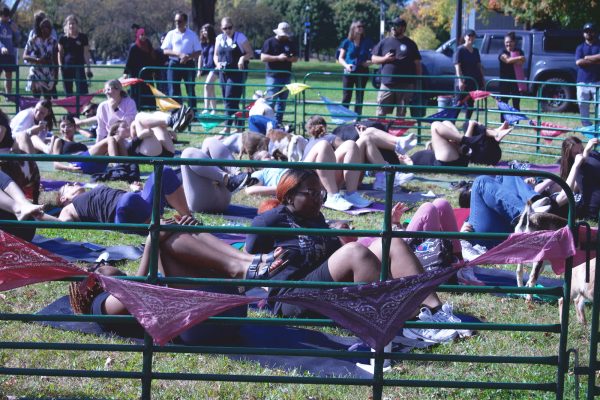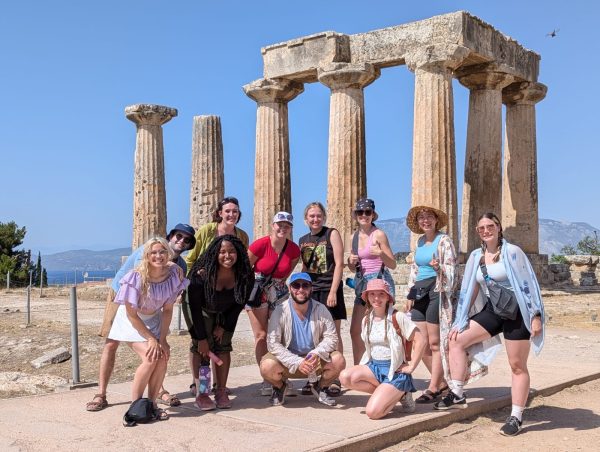Latin American panel highlights unrest in Chile, Haiti, Bolivia
In South America, the people are rioting. From Haiti to Chile, people have taken to the streets demanding change and not backing down. But to those not on location or closely watching, it can be unclear why the continent is all of a sudden in mass protest.
To make the reasons behind the riots as clear as they can be, Oakland University professors Adolfo Campoy-Cubillo, Alan Epstein and Liz Shesko held the “Latin Americans in the Streets: What’s Going On” panel discussion on Thursday, Nov. 21. The professors discussed ongoing conflicts in Chile, Haiti and Bolivia.
The background and history of the countries and protests examined in the story were provided during the panel.
Chile
In Chile, people took to the streets in the capital Santiago after metro prices went up to become the most expensive in South America, sparking people to rush the stations in protest. Campoy-Cubillo said the history of wealth inequality is why the people are in the streets, and the fare hike was the final straw.
“Most people do not decide to take to the streets over something that is not supposed to be important,” Campoy-Cubillo said.
He tied the start of Chile’s current woes back to the U.S.-backed coup in 1973. With the help of the CIA, the Chilean military attacked and overthrew the democratically elected government of Salvadore Allende and replaced him with the military government of Augusto Pinochet. As Pinochet ordered over 40,000 dissenters to be imprisoned, tortured and killed, American-backed economists known as the “Chicago Boys” used the dictatorship to experiment with neoliberal policies.
While the Chilean economy has improved since the collapse of the Pinochet regime, over 40 years of neoliberal economic policies made it so only about seven wealthy families have power while normal people struggle to get by. Already having to stretch every cent, having to pay an extra 50% on essential transit services was what it took for the tension to break.
Haiti
In Haiti, high prices for essential goods also contributed to protests that started in July 2018 and continue to this day.
“I think that the protests that have been going on … in Haiti are the most persistent, broadly-based and … impassioned that I have seen in the last 20 years,” Epstein said. “Not since the last dictatorship was overthrown in 1986 has there been protests like this.”
Back in 2005, Haiti entered into the Venezuelan-led Petrocaribe agreement. This allowed Caribbean nations to buy Venezuelan oil and pay up to 60% up front and spend up to the next 25 years paying off the rest. A Petrocaribe fund was also created that accumulated an estimated $4 billion for national development.
Petrocaribe was “officially dead” by 2018, according to Epstein, causing fuel shortages in Haiti that lead businesses unable to operate, hospitais shut down, morgues unable to refrigerate corpses and general chaos within the Hispaniola nation. As the Haitian Senate tries to use the $4 billion fund to buy more fuel, they discovered that $2.3-3.8 billion were missing. An investigation pointed to President Jovenel Moïse as the culprit. The International Monetary Fund (IMF) also approached Haiti to offer loans if they agreed to end their fuel subsidies. The Inter-American Development Bank (IDB) also promised Haiti money in exchange for privatizing their electric utilities, an act that would increase electric prices.
Between the theft from the Petrocribe fund, the end of fuel subsidies and the high cost of private electricity, Haitians have flooded into the streets demanding Moïse to resign. He has refused to step down and protests have been ongoing since July 7, 2018.
Bolivia
While Chile and Haiti have easily traceable motivations and goals, the violence in Bolivia is murkier. Similar to movements in Venezuela, protests in Bolivia are largely backed by the upper and middle classes rather than lower classes.
Bolivian President Evo Morales has been in control for roughly 14 years. During that time he has championed indegenous rights and but has lost popular support over the years. Before the most recent elections a referendum decided that Morales should not run for reelection, though he proceeded to anyway. Morales won the election, though the election systems shutting down during the vote casted doubts on the victory.
The vote was further put into question once the U.S.-backed Organization of American States (OAS) released a report declaring the Morales’s election fraudulent. Despite agreeing to hold new elections, the Bolivian military forced Morales to resign and have thrown the country into political chaos. A right-wing party has since wrangled themselves into power despite lacking the votes in the legislature and the self-declared “interim president” Jeanine Anez giving the military free reign to attack protests by exempting them from criminal prosecution for any actions taken. At least nine protesters have been killed so far.
Despite indications of U.S. involvement, the lack of popular support for Anez’s regime and the major role the Bolivian military played in deposing Morales, some Bolivians are hesitant to call this coup for what it is.
“People feel very strongly that they do not want it to be called a coup because they feel like the people have gone into the streets and they have demanded change of an illegitimate government,” Shesko said. “I do not know how you do not call it a coup. The military had a role in it. It is an unconstitutional change in power.”
Despite the Bolivian unrest being a coup, the Chilean protests being sparked by fares and the Haitian people taking to the streets over a scandal, all of these protests have one thing in common: people want change and they want it now.












